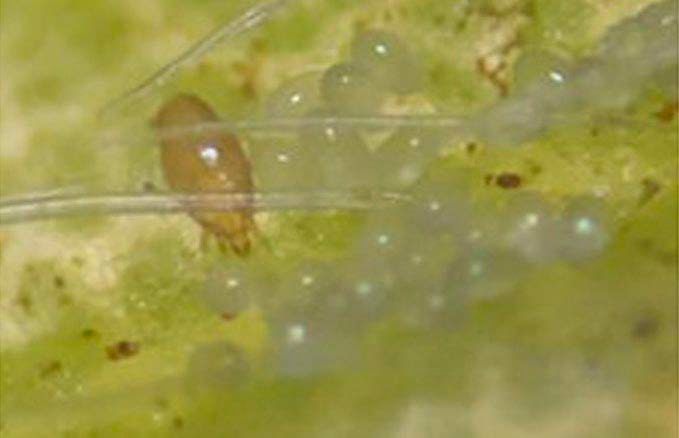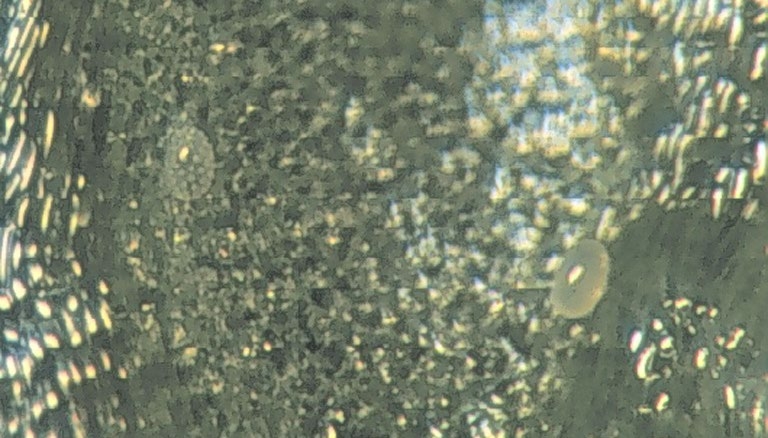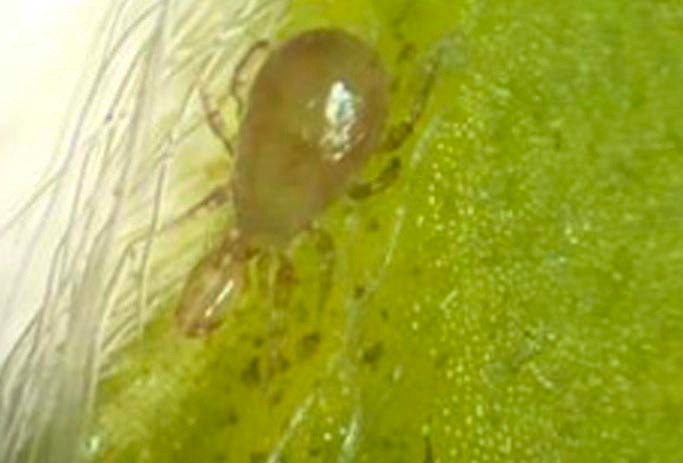Cyclamen Mite in Virginia Strawberries
ID
ENTO-451NP
Introduction
The cyclamen mite, Phytonemus pallidus (Banks, Acari: Tarsonemidae) also known as the strawberry mite, is an economically important pest of strawberries. This species was described based on specimens collected from greenhouse-grown chrysanthemums in New York in 1898. It was discovered for the first time on field strawberries in 1928 in Maryland, New York, and Massachusetts. Today, this pest is distributed throughout the world including all strawberry-producing states in the U.S. in the open field and protected structures.
Cyclamen mites are an intermittent but problematic pest that can cause significant yield losses for growers and nurseries due to the challenges to produced certified clean plants. In Virginia, overwintering females can become active in March or April when temperatures start rising. Symptoms may be observed around May depending on the environmental conditions due to high reproductive potential and overlapping generations. In 2021, strawberry growers in Virginia reported cyclamen mite outbreaks in the Hampton Roads region, the largest strawberry-producing area in the state. With approximately 40 planted acres per year valued at one million dollars, Virginia’s strawberries are at risk of future cyclamen mite infestations and there is a need to inform growers about this pest and management options.
Identification and Life Cycle
Developmental stages include egg, larva, “pupae” or quiescent stage, and adults. Development from egg to adult takes 8-20 days depending on the environmental conditions. Optimal conditions for cyclamen mite development include high humidity (70-90%) and temperatures ranging from 60-80°F (15-27°C). Temperatures higher than 96°F would cause mite and egg death.
Cyclamen mite eggs are translucent, opaque, and smooth (Fig. 1). Eggs are elliptical and relatively large (0.004 in or 0.1 mm long) compared with the size of the adults. High humidity is important for egg survival due to its soft shell that can easily collapse under dry conditions. Larvae hatch in 2-3 days at 68°F (20°C) and 9-13 days at 59-64°F (15-18°C)

Six-legged larvae are white, opaque, and about 0.008 in (≤0.2 mm) long. Larvae are highly active for about 4-7 days depending on the temperature. Larvae develop into a “pupal” or quiescent stage during which a fourth pair of legs is developed. Pupae are the same size as the larvae, are immobile, and take 2-7 days to molt into adults.
Adult cyclamen mites are minute only about 0.01 in (0.2 mm) long and cannot be easily seen with the naked eye. Adults are elliptical, shiny, and translucent or orange-tinted. Adult males are slightly smaller than females and the hind legs of females are thread-like whereas hind legs in males end in a claw. Males use their hind claws to guard females and/or move them during mating. This species is mainly parthenogenic allowing unmated females to lay male eggs. Mated females lay an average of 2-3 eggs per day and about 90 eggs during their life of which ~95% are females (Fig. 1). Cyclamen mites undergo overlapping generations in Virginia and a new generation can develop in less than two weeks during warm spring seasons.
Other mite pests can be found in strawberries such as the two-spotted spider mites (Tetranychus urticae Koch, Acari: Tetranychidae). This is also a major pest in strawberry crops but is easily differentiated from cyclamen mites due to its bigger size (~0.4 mm long) and difference in appearance. Additionally, cyclamen mites are found in folded leaves deep in the crown whereas two-spotted spider mites can be seen with the naked eye and are usually found in mature fully open leaves.
Broad mites (Polyphagotarsonemus latus Banks, Acari: Tarsonemidae) were recently reported infesting strawberry fields in Florida, indicating that this pest may be of consistent concern for strawberry growers in Virginia in upcoming years. If mixed infestations are suspected, cyclamen mite populations can be differentiated based on egg morphology. Broad mite eggs have microscopic white marks unique to this species unlike the smooth eggs of cyclamen mites (Fig. 2). Additionally, the morphology of the hind legs in cyclamen mites is of great importance to differentiate them from non-damaging species in the Tarsonemidae family.

Damage
Cyclamen mites live and feed on the inside of folded leaves and the underside of newly unfolded leaves within the crown of the strawberry plants, as well as inside flower buds and fruit calyxes. Females overwinter deep inside the crown of the plants and the soil posing a major threat to 2nd-year plantings.
Due to their minute size, cyclamen mite infestations are commonly unnoticed and only identified when symptoms occur. Symptoms of cyclamen mite infestation include severely crumpled and crinkled leaves, as well as stunted plants. Plants with severe infestations are stunted because petioles fail to elongate, leaves become dwarfed, and leaflets do not unfold and become brittle (Fig. 3). Additionally, flowers and developing fruit becomes dry and brittle under severe infestations.

By the time symptoms occur, plants usually hold large populations of cyclamen mites and yield may be already affected. Cyclamen mites require high humidity and warm temperatures to reproduce; therefore, strawberries grown under protected structures and nurseries are more at risk of infestations.
The production of certified clean plants is very difficult and strawberry nurseries usually use multiple control tactics to guarantee that the plant material is free of cyclamen mites. Despite their efforts and protocols, cyclamen mite infestations originating in nurseries are common. The mite outbreaks reported in 2021 in the Hampton Roads area were traced back to a severe infestation in a nursery in North Carolina. The mites overwintered during the fall and winter of 2020; mites were detected in the nursery in April 2021, and mites and symptoms were detected in May 2021 in strawberry fields in Eastern Virginia. Cyclamen mites were detected mostly on ‘Ruby June’ strawberries, but they can infest any strawberry cultivar.
Management
Acquisition of certified clean plant material is the first line of defense against cyclamen mites. Early detection in the field and protected structures is arduous but vital for the management of this pest. Cyclamen mites are easily dispersed by the wind or hitchhiking on insect bodies such as bees, true bugs, as well as birds; thus, they can be moved from multi-year strawberry plantings to annual plantings. They can also be transported on farm equipment and people’s clothes. Cyclamen mites are also a major pest of cyclamen plants and can be transmitted from ornamental nurseries to strawberry fields.
Strawberry growers in Virginia should beware of the presence of this pest mite in spring. Scouting should be conducted not only in mature leaves but also in folded leaves.
Chemical Control
There are very few miticides available for the control of cyclamen mites. Currently, the products registered against this pest are Portal (fenpyroximate) and Agri-mek (abamectin). Both miticides stop feeding activity and egg-laying, causing death within a few days. The use of adjuvants for homogeneous coverage is highly recommended in both product labels since the crown of the plants shields the mites from non-systemic miticides. Therefore, high volume (200 gal/acre) and high-pressure applications (≥100 psi) are recommended to provide sufficient control.
Unfortunately, the same products used for control of two-spotted spider mites do not always provide control against cyclamen mites. Despite being commonly used miticides, Acramite and Magister are not labeled for control of cyclamen mite. However, Magister is already registered for control of tarsonemid mites such as broad mites in other states (e.g., FL, SC, NC) and is undergoing studies to include cyclamen mites in its label in the future.
Cultural Control
Cyclamen mites are highly susceptible to high temperatures. Thus, various nurseries, government, and university breeding programs use hot-water treatments for 30 mins at 100°F (37.8°C) or 15 minutes at 111°F (44°C). Longer treatment periods or temperatures exceeding 123°F (51°C) will cause plant damage. If infestations are suspected, dip the plugs in hot water before planting. Equipment and supplies such as trays, gloves, and protective gear should be treated as well whenever possible.
Biological Control
Biological control with predatory mites is a promising technique for cyclamen mite suppression at the early stages of the crop when pest mites are present but hardly detected. Neoseiulus californicus and Neoseiulus cucumeris (Acari: Phytoseiidae) are two predatory mite species that have shown potential against cyclamen mites (Fig. 4). These generalist predators can feed on multiple insect and mite pests found on strawberries including two-spotted spider mites and some thrips. They can also feed on pollen, when prey is scarce.

Successful suppression of cyclamen mites by predatory mites depends on well-timed releases. Freezing temperatures limit predator reproduction and viability, and sometimes providing additional pollen resources is necessary. When environmental conditions are optimal for the predatory mites, they can establish in the strawberry plants early in the season for several weeks suppressing pest populations. Additionally, high-quality predators from trustworthy providers are necessary to guarantee the appropriate performance of the predators. Biological control programs tailored for strawberry growers in states like California and Florida are commonly implemented to suppress pest mites (see LeBeck and Leppla, 2018 in the reference section for a list of providers).
Virginia represents the third strawberry-producing state in the U.S. and its commercial plantings show potential to develop integrated pest management programs tailored for their u-pick systems by combining biological control and miticides against cyclamen mites and spider mites. Thus, local research needs to be conducted in Virginia to develop appropriate biological control programs to suppress cyclamen mites at the early stages of the strawberry crop in the state.
References
Brannen, B. and B. Cline. 2021. “2021 Southeast regional strawberry integrated pest management guide focused on plasticulture production.” Available at: https://smallfruits.org/ipm-production-guides/
Croft, B.A., P. D. Pratt, G. Koskela, and D. Kaufman. 1998. “Predation, reproduction, and impact of phytoseiid mites (Acari: Phytoseiidae) on cyclamen mite (Acari: Tarsonemidae) on strawberry.” Journal of Economic Entomology 91(1): 1307–1314.
Flanagan, R. 2020. “City of Virginia Beach 2020 agricultural fact sheet: strawberries.” Available at: https://www.croatanbeach.org/wp-content/uploads/2020/04/Strawberry-Fact-Sheet-2020.pdf
LeBeck, L.M., and N.C. Leppla. 2018. “Guidelines for purchasing and using commercial natural enemies in North America.” Available at: https://ipm.ifas.ufl.edu/applying/Revised%20Guidelines%20for%20Natural%20Enemies%20to%20Post
Patenaude, S., S.Tellier, and V. Fournier. 2020. “Cyclamen mite (Acari: Tarsonemidae) monitoring in eastern Canada strawberry (Rosaceae) fields and its potential control by the predatory mite Neoseiulus cucumeris (Acari: Phytoseiidae).” The Canadian Entomologist 152(2), 249-260. doi:10.4039/tce.2019.75
Pfeiffer, D. “Cyclamen mite: “Steneotarsonemus pallidus (Banks).” Available at: https://www.virginiafruit.ento.vt.edu/StrwCyclamen.html
Smith, L.M. and E.V. Goldsmith. 1936. “The cyclamen mite, Tarsonemus pallidus , and its control on field strawberries.” Hilgardia 10(3): 53–94. doi.org/10.3733/hilg.v10n03p053
Turechek, W.W., and N.A. Peres. 2009. “Heat treatment effects on strawberry plant survival and angular leaf spot, caused by Xanthomonas fragariae, in nursery production.” Plant Disease 93(3): 299-308.
Virginia Cooperative Extension materials are available for public use, reprint, or citation without further permission, provided the use includes credit to the author and to Virginia Cooperative Extension, Virginia Tech, and Virginia State University.
Virginia Cooperative Extension is a partnership of Virginia Tech, Virginia State University, the U.S. Department of Agriculture, and local governments. Its programs and employment are open to all, regardless of age, color, disability, sex (including pregnancy), gender, gender identity, gender expression, genetic information, ethnicity or national origin, political affiliation, race, religion, sexual orientation, or military status, or any other basis protected by law.
Publication Date
October 13, 2021



